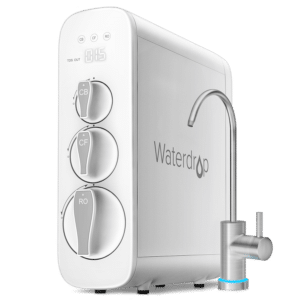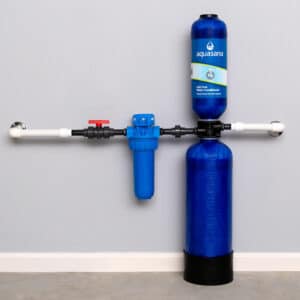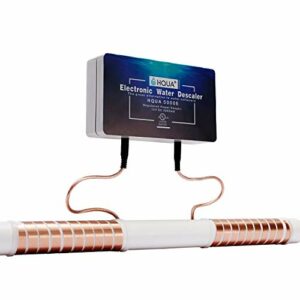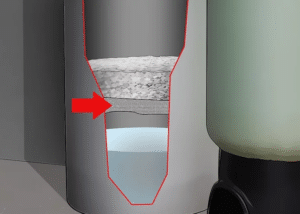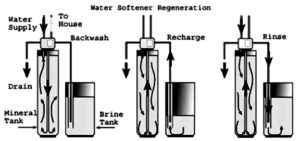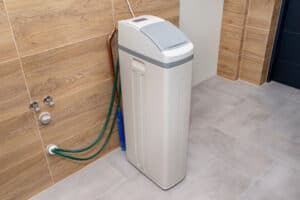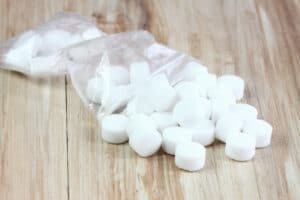If you’re familiar with the benefits of filtered water, then you know that buying the best under sink water filter can be a total game changer in terms of improved health and the amount of money you’ll save each year by canceling your water delivery service.
But if you’re shopping around for an under-sink water filter system you’ll soon realize that choosing the right model for your home at the right price is a lengthy process and one that can feel a little overwhelming considering the hundreds of models available.
For example, you’ve probably come across reverse osmosis (RO) water systems, but you’re not sure what makes them different from simple or conventional models.
Luckily, we’ve spent months investigating and done all the research for you and chosen the top models of under the sink water filters on the market at a good price.
We’ve looked at their filtering processes, how much water (or gallons) they can filter per cartridge, whether they are NSF certified, and we even spoken with consumers who purchased each system to determine the advantages and disadvantages that you’ll run into with each model.
We hope our reviews of the best under sink water filter and our buyer’s considerations guide will help you to choose a water filter system that’s right for your home and your budget.
Under Sink Water Filter Comparison Table
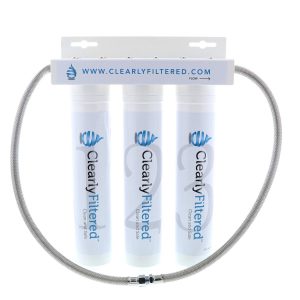
- Filter Stages: 3
- Dimensions: 13.75 x 3.25 x 16.75
- Tank Dimensions: N/A
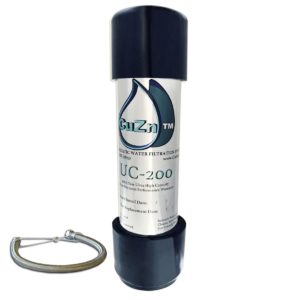
- Filter Stages: 3
- Dimensions: 4.5 x 4.5 x 15
- Tank Dimensions: N/A
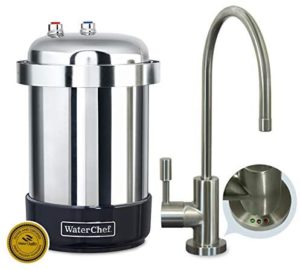
- Filter Stages: 1
- Dimensions: 8.75 x 11.25 x 12
- Tank Dimensions: N/A
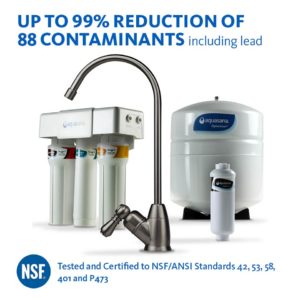
- Filter Stages: 4
- Dimensions: 12″ × 4.5″ × 12.5″
- Tank Dimensions: 16″ × 11″
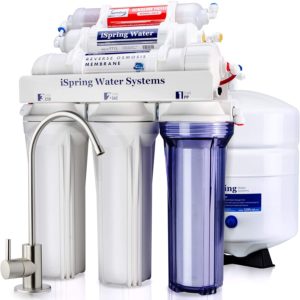
- Filter Stages: 6
- Dimensions: 15 x 8 x 18
- Tank Dimensions: 16″ × 11″
Criteria For Choosing an Under Counter Water Filter
When you’re shopping around, searching for the best under counter water filter, you’ll probably come across many models that are marketed as the best simply because they feature five or seven stage filtration, or other manufacturers will push you to buy, claiming they offer the top-selling reverse osmosis water filtration system.
Often, the more filtration stages a system offers, the higher the price tag. All filtration systems will come with at least three filters that the water will pass through before it reaches your glass. Some of the top of the line under the sink systems come with five to seven.
Generally speaking, the more filters the water has to pass through, the cleaner the water will be. This is because each of the filters is designed to capture certain types of contaminants such as lead. Just keep in mind that the seven-stage filtration systems are often very large and bulky, which can make installation a nightmare if you don’t have much space to work with under the sink.
There are also several types of filters to choose from. Most models will come with pre-filters, which are designed to remove cloudiness and sediment. They’re also usually equipped with a standard carbon-based block that will capture chlorine and other contaminants. Higher priced models will come with a UV filter or a reverse osmosis filter, both of which are said to capture more contaminants than a basic carbon filter.
When it comes to installation, installing one of these systems can be tricky if you don’t have any experience or not much space under the sink. These filters are installed under the sink, directly into the water line. Some systems will filter all of the tap water that flows through the faucet, while other models will require a more heavy-duty installation that involves drilling a hole in the countertop or the deck of the sink for a separate faucet filter.
Reviews: Best Under Sink Water Filter
Here are our top picks for best under counter water filter:
- Waterdrop WD-G3-W
- Clearly Filtered 3 Stage System
- CuZn UC-200
- Waterchef U9000
- Aquasana OptimH20
- iSpring RCC7AK
- Pentair Pelican Under Counter Water Filter
1. Waterdrop WD-G3-W Under Sink RO System
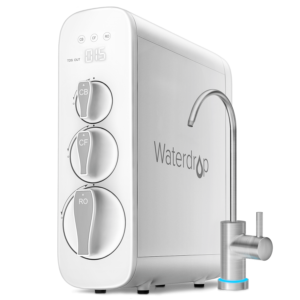
In our opinion, the best under sink water filter is Waterdrop WD-G3-W, a unique take on the usual reverse osmosis (RO) system that is standard in so many kitchens. Typically, these RO systems have 2 components; one is the part that you see which is the spigot that delivers the conditioned water to you, and second, is the actual workings of the system that is situated under the sink.
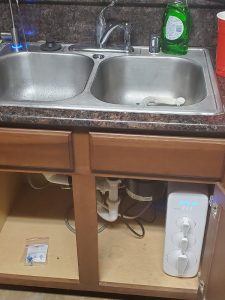
Waterdrop is not different in that way since it also comes with a stylish spigot for the sink and then the actual water treatment unit is under the sink. The key difference is that the WD-G3-W is a tankless system. Most traditional RO systems have a tank under the sink that collects water after RO is performed to purify the water.
The WD-G3-W features a large membrane that purifies water quickly and eliminates the need for a holding tank for purified water. The reason traditional RO systems have a tank is that purifying the water via RO is slow and the tank acts as a buffer to make sure the water is available to the consumer. Waterdrop specifies that the WD-G3-W unit can purify up to 400 gallons per day (GPD). Traditional RO systems, by contrast, can only treat 50 gpd.
The different tankless design also means that the unit can be installed by more people as a DIY project versus needing to hire a professional. It also has a benefit of taking up much less under sink space than traditional RO systems. Another design benefit is that this Waterdrop unit features a lighted monitoring panel to alert the consumer to when the filter is nearing replacement time of its overdue. Traditional systems have no such indicator and keeping up with filter replacements with those is mainly a checking your calendar type of an affair.
Overall, the Waterdrop WD-G3-W is an excellent different design from the typical RO system. It can deliver water fast, has a 7-stage filtration process, features 3 easily changed filters, takes up less under sink space, holds multiple NSF certifications, and is price competitively.
- 400 gallon of water output every day
- Integrated feedback system lets you know the filter’s status
- Easiest installation of any RO system
- Sleek and slim design will save sink space
- NSF/ANSI 58 certified for TDS Reduction
- More expensive than some of its rivals
- The system cannot be placed sideways
- The water flow could be faster
2. Clearly Filtered 3-Stage Kitchen Filter

Our second recommendation for best under counter water filter is the Clearly Filtered 3-stage system which is a great choice especially for the fact that it also removes fluoride from water.
Clearly Filter has one mission: to make tap water as close to 100% pure as possible through their proprietary Affinity Filtration Technology.
Affinity filtration employs multiple stages to ensure that water is 99.7% free from 232+ contaminants. Designed and built in the USA, the Clearly Filtered 3-Stage Filter System is a slim, compact, yet powerful filtration that takes up little cabinet space. (it’s only 3” deep!)
Stage one removes chlorine and VOCs while improving taste by eliminating odors and cloudiness. Stage two destroys 99.9% of heavy metals, VOCs, pesticides, herbicides, arsenic, lead, chromium, radiation, and PFAS. Stage three tackles arsenic and fluoride, which is a perk because many filters don’t address fluoride. You can check out the independent lab results here for all the contaminants removed.
Another plus: the filters are truly long-lasting, only needing replacing after 2,000 gallons. This means around 9-15 months, depending on your household size. To replace filters, all you do is screw off the old one, screw on the new one, and you’re done. No hassle.
Sometimes companies say their filtration systems are “easy to install,” but after several hours and an emergency call to the plumber, you realize that’s not the case. Clearly Filter boasts DIY installation (15 minutes—no plumber needed!) By the way, the record is 2 minutes, 2 seconds! Also, the non-permanent install goes through the existing cold water line, so no drilling into your countertop or sink modifications. Perfect for renters.
Clearly Filtered comes with a higher price tag than some, but with the quality you get, we believe it’s a good investment. Plus, you get a 30-day money-back guarantee, a lifetime warranty on this system, and free shipping.
- Reduces 232+ contaminants including fluoride
- Easy to install (for real)
- Great for renters
- 2,000-gallon filter capacity
- Lifetime Warranty
- Higher price tag than competitors
- May reduce cold water flow
3. CuZn UC-200 Under Counter Water Filter

The CuZn UC-200 Under Counter Water Filter is also an excellent choice especially if you have chlorine-treated municipal water. This system efficiently removes chlorine, lead, mercury, VOCs, chromium 6, pesticides, herbicides, and other water contaminants with a three-stage filtration process.
The filter includes Micro Sediment Membranes, along with a patented combination of KDF-55 Filtration Media and Virgin Acid Washed Catalytic Coconut Shell Carbon Filtration Media that have been tested to NSF standards 42 and 61.
The CuZn is bacteriostatic, which means it is not susceptible to bacteria growth or mold. Do note that while the CuZn UC-200 will filter most contaminants, it is not a water softening system, so it won’t resolve issues such as limescale mineral deposits. Also, the UC-200 does not reduce TDS readings, so a TDS reader is not effective in this case.
This small, yet powerful system connects directly to the cold water supply under your sink, so you won’t need to install a separate faucet. Even better, the installation is incredibly simple and can be done in five minutes! The rate of flow is 2 GPM, which is pretty good. The CuZn is designed to filter up to 50,000 gallons, which typically lasts five years and is proudly made in the USA. The value of this system is great since it is reasonably priced and known for its longevity.
Cost and efficiency, along with excellent customer service and a 90-day satisfaction guarantee, make the CuZn UC-200 Under Counter Water Filter a great choice.
- Effective combination of coconut shell actives carbon and KDF-55 removes contaminants
- The bacteriostatic element keeps the filter bacteria and mold-free
- Easy to open with one-touch, one-hand flip lid
- Metal tubing rather than plastic
- Long life: 50,000 gallons or five years
- 90-day satisfaction guarantee
- Some customers have reported that the filtered water doesn’t taste as good as it could.
- May be clogged and inefficient by water that is too contaminated.
4. WaterChef U9000 Premium Under-Sink Water Filtration System

Equipped with stainless-steel housing and a one-thousand-gallon capacity rating, this innovative water filtration system by WaterChef is a best-seller for all the right reasons. It features intelligent monitoring that prevents you from tossing out a cartridge before it needs to be replaced. Once a cartridge needs to be replaced, the LED lights on the faucet will switch on and guide you to when a change is needed.
This system features patented big block filtration technology that’s designed to eliminate a wide range of water contaminants from your tap water, such as chloramine, chlorine, MTBE, lead, trihalomethanes, benzene, and cysts.
We love that it is NSF certified to deliver quality filtered water and meeting standards for removing contaminants. And, it’s beautiful stainless-steel housing gets positive comments that it’s almost a shame that this unit will hide in your under sink cabinet!
Learn More: WaterChef U9000 Premium Under-Sink Water Filtration System
- The filter is NSF certified
- A three-ply design ensures longer lasting cartridge life and improved contaminant removal, such as lead
- Homeowners will also appreciate the sixty-day money back guarantee, which allows them to try out the system for two months and return it for a refund if they’re unsatisfied with its performance
- thumbs-upBecause the filter system has such a large water capacity, most buyers reported that the cartridge only had to be changed once a year
- Drilling is required in order to install the special faucet. We recommend having the system professionally installed if you don’t have any plumbing experience.
- thumbs-downThere were several reports that the tank began to leak almost immediately after installation, but upon further inspection, we found that this is often due to consumer error and improper installation
Conclusion
For some, the system was a little on the pricey side, but once you take into consideration the low maintenance needs and ongoing costs such as cartridge replacement, you’ll find that while the initial cost is a little high, you’ll save hundreds of dollars in the long-run. Built to last, the lifetime warranty and sixty-day money back guarantee gives consumers every reason to buy. Great unit that takes your tap water and provides excellent filtered quality water.
5. Aquasana OptimH2O® Reverse Osmosis + Claryum

Based in Austin, Texas, Aquasana, Inc is a well-trusted company known for its home water filters and filtration systems. The Aquasana OptimH2O® is an excellent option to remove harmful contaminants and provide the purest drinking water possible, all from your own home.
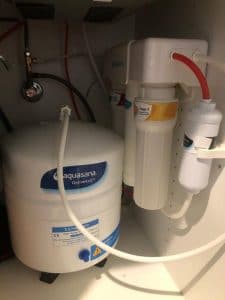
The Aquasana OptimH2O® Reverse Osmosis + Claryum Under Sink Filter is the first of its kind, combining powerful water filtration technology for the purest drinking water to ensure effective hydration. The filtration technology and reverse osmosis efficiently removes fluoride plus 87 other contaminants to ensure the healthiest drinking water. Even better, this system removes five times more impurities than other RO systems.
The Aquasana includes six levels of filtration and remineralization of your drinking water, including reverse osmosis, activated carbon, catalytic carbon, ion exchange, absolute sub-micron filtration, and remineralization. Each step works to filter chemicals such as herbicides, pesticides, lead, mercury, and chlorine, while the remineralization feature adds healthy minerals, such as magnesium, calcium, and potassium, back to your water while maintaining a healthy pH.
With this filter, you will get a 100% lead-free brushed nickel faucet, a set of three filters, a reverse osmosis tank, and the parts you need to install this system. Customers report that the installation is easy, and Aquasana provides three videos on the installation, replacing the filter, and tubing, to guide you. The operating pressure ranges between 40-100 PSI and produces 13.32 gallons of water daily.
- The reverse osmosis system is extremely effective.
- Water passes through six levels of filtration to ensure optimal quality
- Easy installation and maintenance
- Tested and certified to NSF/ANSI standards
- 90-day guarantee/two-year warranty
- Some customers report that the water is a little slower than desired
- The tank does not come with an automatic shut-off feature.
6. iSpring RCC7AK 6-Stage Under Sink Filtration System

This is a reverse osmosis system and unlike other RO systems that features a five-stage filtration process, this model by iSpring features six stages. The system’s innovative membrane is able to remove over ninety-nine percent of water contaminants.
The alkaline remineralization filter will add important, healthy minerals, such as potassium, sodium, magnesium, and calcium, back into the water, significantly improving the taste.
This is an excellent quality (NSF certified) under-sink filter for the price from a reputable company that will deliver gallons of clean safe filtered water free of bacteria, lead, fluoride, and other bad contaminates. Water pressure remains high.
Replacement filters are readily available and will need to be changed roughly every 6-12 months, depending on your usage and how many gallons are filtered.
Learn More: iSpring RCC7AK Reverse Osmosis Drinking Water Filter
- You’ll get unlimited lifetime support, a one-year product warranty, and a one-year money back guarantee
- This system also uses red mineral stones alongside basic calcium carbon filter
- It can remove over a thousand different types of pollutants, lead, and contaminates from your drinking water
- You’ll have to leave some time for the system’s tank to fill up with purified water, which means it’s not always readily available
- The installation process is lengthy and complicated
Conclusion
Reverse osmosis systems have a reputation for producing the purest water, and with the addition of a sixth filtering stage, you won’t doubt this system’s efficiency. Because it has a dedicated faucet, you also won’t have to worry about a drop in water pressure.
Overall, this effective water filter system by iSpring ensures that you’re drinking only the purest, best-tasting drinking water, without the hassle of changing out filter cartridges once a month. NSF certified and readily available replacement filters make it easy to like.
It ranks high on the list of best under sink water filter, perfect for your kitchen or office.
7. Pentair Pelican 3-Stage Under-Counter Drinking Water Filter
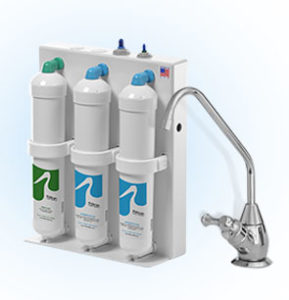
Chlorinated water not only tastes and smells bad, but it can also cause health issues down the road. If you are looking for a chlorine filter that produces great-tasting, pure water with a compact, eco-friendly design, the Pelican 3-Stage Drinking Filter (PDF-1500) offers 1,500 gallons of pure, filtered water with minimal maintenance and absolutely no water waste. Proudly designed, manufactured, and assembled in the USA, this system is compact, easy to maintain, and best of all, will give you great-tasting, odor-free filtered drinking water, free of contaminants including chlorine and chloramine.
Pelican’s three stages of filtration include the 25 Micron Pre-filter and two Catalytic GAC Carbon filters to remove chlorine and chloramine while retaining calcium and magnesium to ensure great-tasting drinking water. The water pressure is 40-80 PSI, and this system will produce 1,500 gallons of water, which is especially effective for smaller homes.
The small footprint this product boasts is worth mentioning. True to Pelican’s mission of environmental sustainability, this filter leaves a small footprint and uses fewer resources throughout the manufacturing processing than many of its competitors. This compact design is 12.5” W x 15” H x 4.5” D and comes with three stylish faucet options in chrome, brushed nickel, or bronze.
Installation is simple with hygienically sealed filter cartridges, color-coded fittings, and a detailed user guide. However, maintenance is even simpler. All you do is remove the cover and replace the cartridge every 6-12 months depending on usage. There are no additional tools needed. Pelican offers a one-year limited warranty on this filter and all parts.
- Three-stage filtration process filters out chlorine and chloramine
- Carbon media retains calcium, magnesium, and other beneficial minerals
- Compact design
- No water waste
- One-year limited warranty
- No certifications listed
- Some customers reported that there were confusing parts in the installation manual
8. APEC Top Tier Under Counter Water Filter System
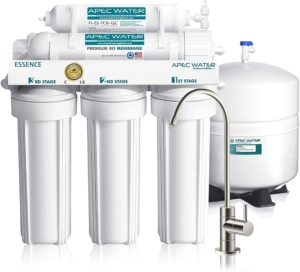
This is a five-stage, simple under the sink water filter system that features a six-thousand-gallon capacity, offering a two and a half gallon flow of purified water per minute. Because this is a simple system, there’s no drilling required and no additional faucet to install. Instead, you’ll enjoy an endless supply of purified water via the cold water from your dedicated faucet.
The manufacturer claims the filter system can remove a wide range of harmful chemicals including chlorine, lead, heavy metals, parasitic protozoan cysts, benzene, toxaphene, p-dichlorobenzene, and much more.
There was some mixed feedback regarding ease of setup. Some buyers claimed it took them as little as an hour to install, while for others, it was a complicated process that resulted in calling in a pro. Bottom line, if you have little to no plumbing experience, we recommend having it professionally installed to save yourself the headache.
Learn More: APEC ROES-50 Reverse Osmosis Water Filter System
- This filter system treats both well water and tap water and has a large capacity
- APEC offers online instructional videos that help to simplify the installation process and are easy to follow
- The five-stage filtering process ensures pure, delicious drinking water that’s free from impurities and harmful chemicals
- After filtration, you’ll enjoy clean crystal clear and great tasting water
- This model comes with a separate faucet for purified drinking water, which means a more complicated installation process. If you have no plumbing experience, professional installation is recommended, so you’ll need to factor this additional cost into your budget
- There were numerous reports that the included plastic fittings had to be replaced immediately because they often leaked
9. Culligan US-600A Drinking Water Filtration System
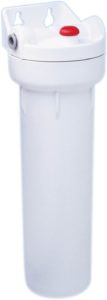
This is a three-stage, simple under the sink water filter system that features a six-thousand-gallon capacity, offering a two and a half gallon flow of purified water per minute. Because this is a simple system, there’s no drilling required and no additional faucet to install. Instead, you’ll enjoy an endless flow of purified water via the cold water from your existing faucet.
The company claims the filter system can remove a wide range of harmful chemicals including chlorine, lead, heavy metals, parasitic protozoan cysts, benzene, toxaphene, p-dichlorobenzene, and a long list of other contaminants it takes away.
The filter is NSF certified, so you can be confident about the quality and how effective the filter is going to work.
- The filter is NSF certified
- Because you don’t have to install a second faucet, the installation process is actually very fast and easy
- This system allows you to simply turn on your cold water faucet and instantly enjoy an endless flow of purified water that you can drink and cook with
- Since the purified water is flowing through your existing faucet you can expect a change in water pressure, although most buyers reported that the change in pressure was not significant
Conclusion
There are many lower priced water filter systems on the market just like this one from Culligan that can deliver gallons of filtered water. They’re priced low to get you to buy, but they don’t come with the right components and tend to arrive with shoddy parts that will crack or split just months down the line. The fact that these cartridges begin to disintegrate and end up in your drinking water should be more than enough reason to pass this model by at this time.
10. 3M Aqua-Pure
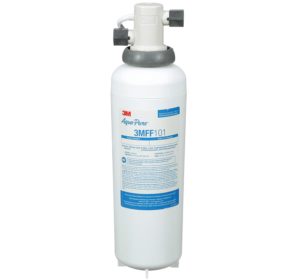
This is a three-stage, simple under the sink water filter system that features a six-thousand-gallon capacity, offering a two and a half gallon flow of purified water per minute. Because this is a simple system, there’s no drilling required and no additional faucet to install. Instead, you’ll enjoy an endless supply of purified water via the cold water from your dedicated faucet.
The manufacturer claims the filter system can remove a wide range of harmful chemicals including chlorine, lead, heavy metals, parasitic protozoan cysts, benzene, toxaphene, p-dichlorobenzene, and much more.
The filter is NSF certified, which is always a welcome confidence builder in the effectiveness, quality, and safety of the unit in meeting those standards.
- The filter is NSF certified, so it meets high quality standards
- Because you don’t have to install a second faucet and you simply use your normal tap water faucet, costs are lower and the installation process takes little time and can be pretty easy
- This quality system allows you to simply turn on your cold tap water faucet and instantly enjoy an endless flow of purified water that you can drink and cook with in your kitchen with decent water pressure
- Since the purified water is flowing through your dedicated tap water faucet, you can expect a change in water pressure flow, although most buyers reported that the change in pressure was not significant
Conclusion
This system by 3M is a great buy for any homeowner on a budget. If you don’t have any prior plumbing experience, then the fact that this system is so easy to install and maintain will be a big selling point for you.
Additionally, because you don’t have to make room for another faucet, this system will work well for smaller kitchens. Just be mindful of a drop in water pressure and also that you’re treating more gallons of water so expect a higher frequency for replacement of filters.
What is an Under-Sink Water Filter?
An under-sink water filter is a device that is used to filter the water that is coming to a faucet so that the water can be safely consumed. It does this by using some type of filtering process to treat the water so that it is safe to drink or use in cooking.
This is necessary because the untreated water may have a variety of harmful or undesirable things within it, such as:
- Sediment
- Heavy metals
- Fluoride
- Lead
- Chlorine
- Bacteria, and
- A range of other contaminates
As described by its name, an under-sink water filter is one that is installed underneath a typical sink area, whether it’s at home in a business setting. It can be a kitchen sink, a bathroom sink, or even a business break room sink.
The key is that if it is believed that water needs to be treated by the gallons, then an under-sink water filter is a popular choice for doing that job.
Under-Sink versus Countertop Water Filters
There are different types of water filters and it’s important to understand the categories in order to make the best decision about your needs. One of the differences in water filter types is where they are placed, such as under-sink or countertop.
Thankfully, the names of these different types describe simply the main characteristic of each. The under-sink water filter is meant to reside in that area directly beneath the sink, where as the countertop water filter resides on either the counter-top next to the sink or directly inside or on the sink itself.
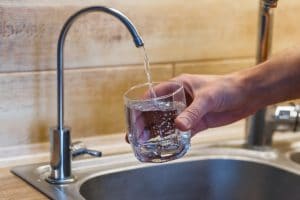
Because of the amount of space that is available underneath a sink versus on a countertop and for aesthetic reasons, it is expected that under-sink water filters will typically be of larger size and less aesthetically presented when compared to countertop water filters.
Especially for the home kitchen environment, the amount of space on a countertop if often limited and homeowners will be sensitive to how much room is required for a water filter.
Equally important many times if how appealing the look of the water filter may be if its intending to reside on the countertop all the time and be in plain view. The best countertop water filters will address these concern areas by being small and visually appealing.
Who Should Buy an Under-Sink Water Filter?
Homeowners that value their countertop space or may have small kitchens should consider an under-sink water filter. Because the under-sink water filter systems reside underneath the sink, they allow the homeowner to not take up valuable countertop space that may be limited or preferred to be used for other appliances and activities.
Visual appeal, noise, and cleanliness are also good reasons for homeowners and business owners to consider an under-sink water filter. Especially if you have a closed off cabinet type of enclosure underneath the sink, then the under-sink water filter system can be placed in this area away from eyes, ears, and hands.
One other common feature of under-sink systems is the fact that they are larger and can provide more filtration capability and treated water storage. Since the area underneath the sink is typically larger or less valuable in terms of usage than a countertop, the under-sink water filter systems are larger in size (with tanks holding many gallons of filtered water) and can simply do more filtering and hold more treated water.
So, larger households and businesses that want more water available quicker without needing to wait for a smaller and slower countertop water filter system would be better served with an under-sink water filter device.
When shopping for one of these under-sink units, you should of course read our reviews above to get oriented towards the quality of products available. We also make it easy for you to check the price of each of the products by clicking on the Amazon product link.
One thing to pay attention to is check if the unit is NSF certified. This NSF certification is one more point of confidence that you’re buying an effective system and a quality company. Also, pay attention upfront to replacement filter costs and how often you require to change them.
Advantages & Disadvantages of an Under-Sink Water Filter
When comparing to a countertop system, you will find that the advantages that an under-sink water filter system has is directly related to its disadvantages. For example, because we described that the space underneath a sink is less utilized and valuable, the systems are larger.
This means that the filtering mechanisms or stages are larger in size. This directly impacts how quickly the device can filter water because the flow rates through a stage is faster due to the larger stage.
These under-sink devices usually feature a large water tank, as well, to hold the treated water. So, as the filtering portion of the device filters water, it then makes it available to the user by placing the treated water in a holding tank with good capacity of maybe several gallons.
Again, since we’re underneath the sink area and there’s usually not much there besides maybe dish soap, sponges, and other related items, the holding tank can be of a much larger size. This directly translates to more treated water that is available at any given time.
So, instead of running out of treated water or having to wait for a slow filtering rate from a countertop system, the under-sink system has much more available to fill many bottles or large pots.
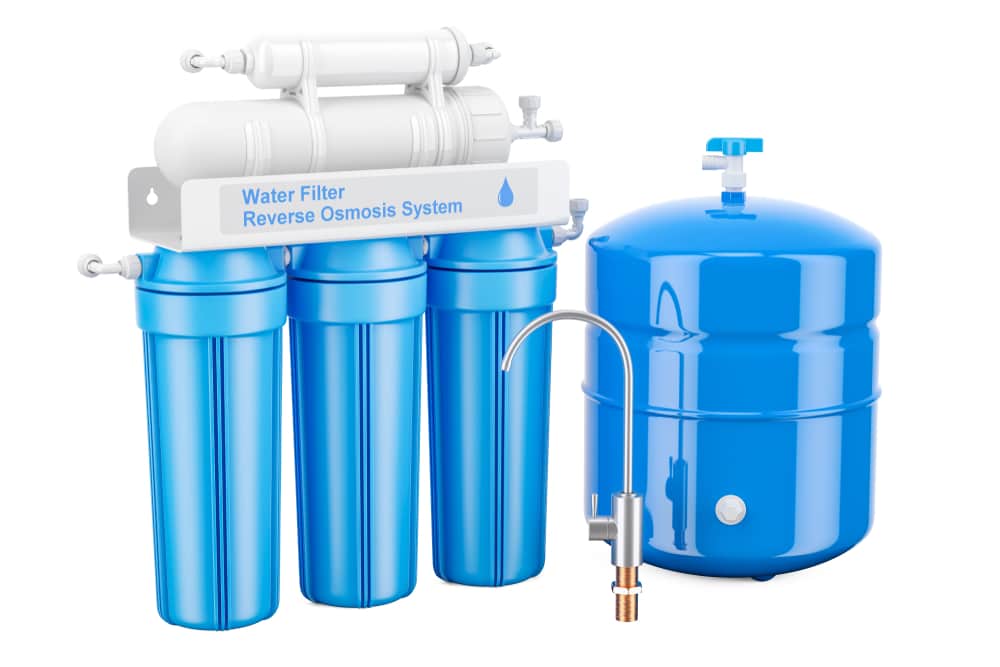
That said, the size aspect of these systems can also be a disadvantage in certain situations. Because under-sink space is not as highly valued, there are situations where kitchen or breakroom plans are such that these spaces may be small sometimes.
So, if there’s not much space in this area and it already has to account for the bottom of the sink that is placed above it and the pipes and plumbing necessary, the buyer needs to carefully consider what kind of under-sink water filter system will actually work in their particular situation.
Another disadvantage of these systems due to size is that even if you do have enough room under the sink to place the unit, you still may have a challenging time installing it. Since the space is small, there’s not a lot of room to maneuver and otherwise make easy work of the unit installation.
The same goes for maintenance, as well. These water filters are generally using activate carbon as part of their filtration process. These and other stages of the filtering mechanism will need to be replaced during some interval of time, depending on how many gallons of treated water is consumed by the owner. So, a small space and often one that may be wet or dirty makes maintenance more challenging when compared to a system that is installed on the countertop.
Under-sink water filters offer a strong advantage for overall effectiveness for their core job of producing treated water. The water from these systems tastes good, is free from harmful contaminates, and does so economically. Since it’s such a popular product, the buyer has a wide range of options to pick a unit that is the best fit for their situation.
Final disadvantage for an under-sink water filter is that it’s limited to just the single sink and faucet where you install it and won’t cover additional points in a house or business. So, if there’s a need to have treated water at other sinks or faucets, you need to purchase and install additional systems.
How Does an Under-Sink Water Filter Work
Under-sink water filters work in two different but straightforward ways. The simplest method way is where the filter system is placed directly in the path of how the cold water makes its way to the sink faucet.
So, in this way, the filter is treating all the water that is going to the same single faucet in the sink above. In this way, the simple system acts sort of like a whole-house water filter. The second method, by contrast, has a separate feed of cold water that is treats and then sends to the sink above with a new second faucet or spigot.
The first simpler under-sink system is treating all water and always has the advantage of providing a larger flow of treated water to the user. This does have a disadvantage in that the faster flow rate means that the water is not spending as much time in the filter to filtered as many contaminates as the second system’s more conventional design.
The conventional design is only treating a part of the cold-water supply and is only being directly accessed when the specific water spigot is used. As a result, this system has more time to filter the water in its stages and produces stronger filtering results.
Besides the pros and cons mentioned above, you can also consider that the simple system will be lower in price and easier to install since there is no additional faucet or water spigot required.
Because also that the simple system is taking all the cold water and filtering it, you’re going to be replacing filters more often. The conventional under-stink system can take more work to install and be of higher price because of the addition of a second faucet and work needed to the sink area.
But, since you’re only treating water that you are using for cooking or drinking and not all of the cold water going through the faucet, you’re going to be changing and buying new filters less often and that will save you money over the longer term.
Under-Sink Water Filter Installation and Maintenance
We can offer some general advice and orient you to the general process of installing an under-sink water filter system. But we strongly urge you to thoroughly read the manufacturer’s instructions that come with your filter device to make sure you’re what is specifically required. Each manufacturer might have specific and slightly different ways to successfully install their product, so it’s important to follow their directions exactly. You also may be at risk of voiding your product warranty should you install the unit incorrectly and damage occurs as a result.
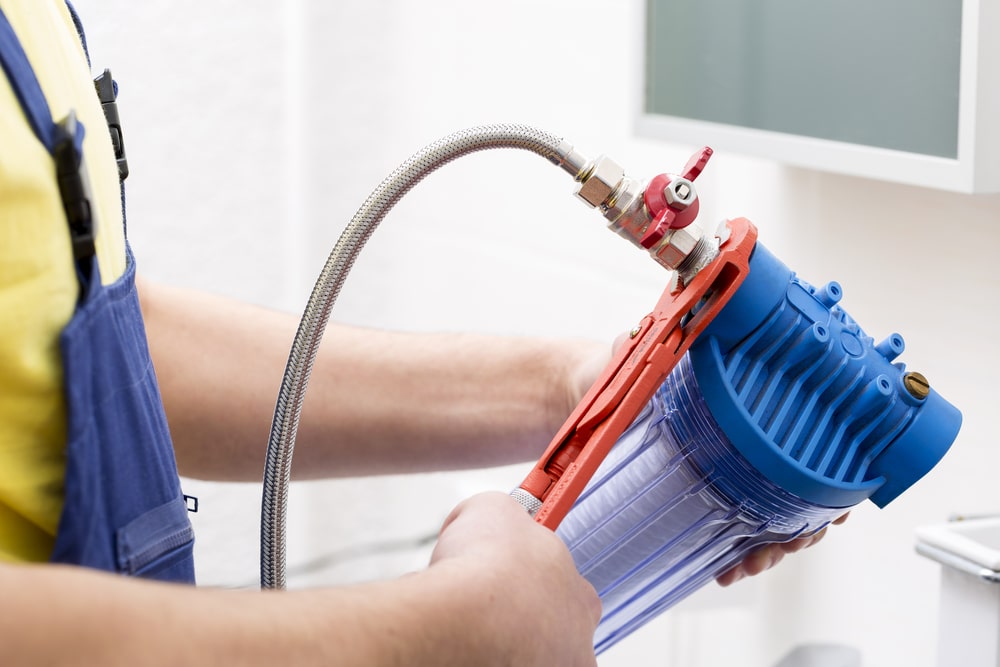
Here’s a general overview of the process involved for the installation a simple under-sink water filter:
- Turn off the cold-water supply via the shut-off valve and remove the water tubing from the valve
- Mark an appropriate area underneath your sink cabinet area for where the water filter unit will reside, go ahead and install it there via the appropriate screws provided
- Insert the water tubing into the “In” portion of your new water filter
- Utilize another piece of tubing to fit from the “Out” portion of your new filter to the faucet, and
- Voila, you’re done and ready to enjoy filtered water now!
The installation process for a convention system isn’t much different. It has all the above steps, but since you’re not simply placing the water filter in the loop of the water to the faucet, you have a few extra steps to take. Mainly, it involves the mounting of a new faucet or water spigot in your sink area. So, instead of the “Out” of your new water filter going to the existing faucet, you are feeding that tubing to the new faucet.
Again, please pay attention to the specific instructions that your unit comes with to make sure you don’t have a frustrating time, damage the unit, or hurt yourself during installation. If you have any doubts, it’s not a bad idea to call a handyman or plumber to give you a hand. If you do like doing projects yourself and you are confident, don’t hesitate to do this project yourself. Here’s an excellent video that shows you what to expect as part of the typical process.
Thankfully, these units are pretty much free of maintenance and the only effort around them is to replace filters occasionally. How often the filters last is mainly a function of how much water you are treating in your household or business. If you are a household of 2 adults, you can expect around 12 months of service from your filters before you need to replace them. A family household of 2 adults and 2 children might need to replace filters every 6 months. As mentioned before, it will also depend on what type of under-sink water filter system you chose. Some of those are more long-lived between filter replacement periods because of the nature of how they work and how much water they’re treating.
Filter Options for Conventional and Simple Water Filter Systems
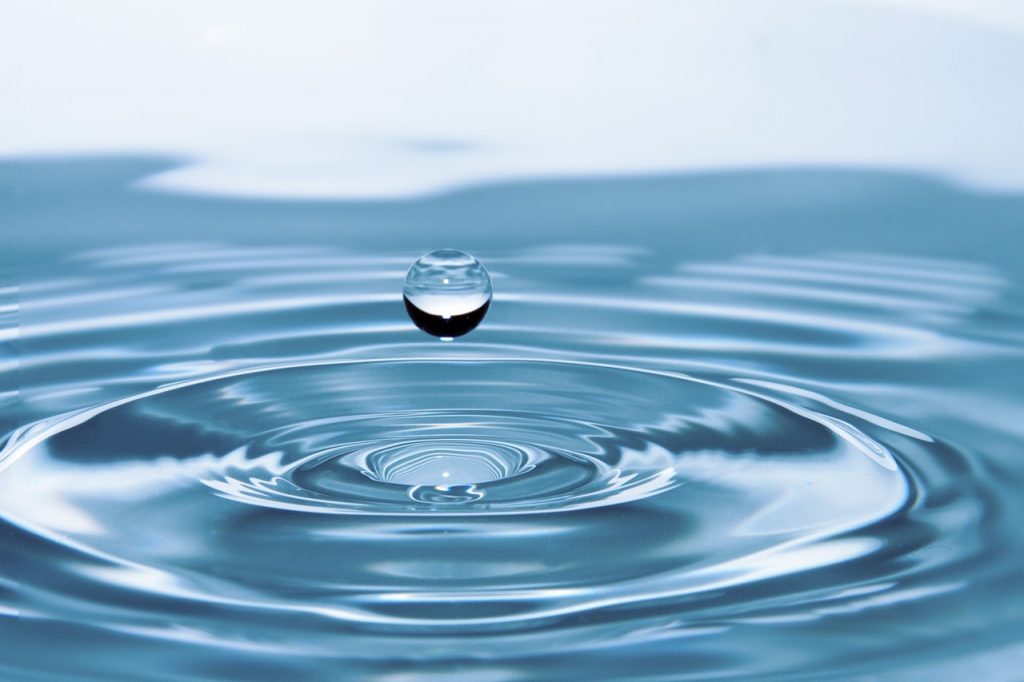
The number of filter stages in addition to the type of filters the under the sink filter system uses will be very important. Unlike traditional reverse osmosis systems, these under the sink filters will process the water on demand, which means you won’t need a connection to a drain or a storage tank. Every drop that will go into the filter will come out as drinkable. These systems are under constant pressure, so when you turn on the faucet, the water will quickly flow through the filter and out the faucet instantly.
For conventional under the sink filter systems, only water that’s delivered through a special faucet will be filtered (this will save you quite a bit of costs on replacement filters). The regular hot and cold water functions usually remain independent of the filter. Simple under the sink models will filter the cold water exclusively. The cold water will be diverted through the filter, so all off the cold water is pure and drinkable. The hot water will not be filtered. Systems that don’t require a separate faucet are more practical and are quickly gaining popularity with homeowners. So, let’s break it down for you.
Conventional under the sink filters are more expensive and you must drill a hole in your sink or counter to accommodate the special faucet. But their filter cartridges will also last longer because you’ll only use the faucet for drinking water. Due to the reduced flow rate, higher quality drinking water is produced. They also feature high capacity tanks that hold the filtered water.
With simple under the sink filters, you don’t have to do any drilling, there’s no complicated installation and they’re also more affordable. However, because the cartridges will end up filtering all of the cold water from the faucet, even water that’s used for cooking or cleaning tasks, the cartridges need to be replaced often. Their higher flow rate also makes some of the filtration tasks less practical.
Modern Filter Systems Vs Reverse Osmosis
These days, new water filter systems can perform the type of filtration tasks that were only possible with reverse osmosis systems. But newer filter systems come packed with a wide range of filter options, each of which can affect the water’s purity in very different ways.
Here is a list of the different types of filters available:
Carbon filter: Almost all models will come with an activated carbon filter and it’s often the cornerstone of most systems. This type of filter will improve the odor and taste of the water. They’re also responsible for removing larger particles from the water, such as silt and sediment. The filter works by absorbing and attracting the large particles, removing them from the water. This type of filter can affect the way the water tastes because it reduces contaminants such as chlorine, which can make water have a sharp or bitter taste.
Reverse Osmosis: This water filter system has been popular for several years, mainly because it can remove all kinds of dangerous contaminants from the water, ensuring that your drinking water is odor-free, clear, and tastes great.
Alkaline: This type of filter utilizes a process that’s known as electrolysis. During filtration, the water passes over plates that are electrically charged. The water is then separated into two streams. One of which is acidic and the other is alkaline.
Here’s a rundown of the types of filters that are needed to remove certain types of contaminants and improve taste:
Taste: Activated carbon
Chemical reduction including chloramines: Specialty carbons that are designed for enhanced chloramine reduction.
Heavy Metals: Activated alumina with iron oxide
Fluoride: Activated alumina
Water Hardness Reduction: Cation resin
Sediment: Spun polypropylene or pleated polypropylene.
Nitrates: Anion resin that’s nitrate selective
Cryptosporidium/Giardia: Carbon block filter, sediment filter, and a ceramic filter
Increase in Ph levels: Calcite
Bacteria: Ceramic filter
To Reduce Minerals: De-ionizing cartridge
Why are Reverse Osmosis Systems So Popular?
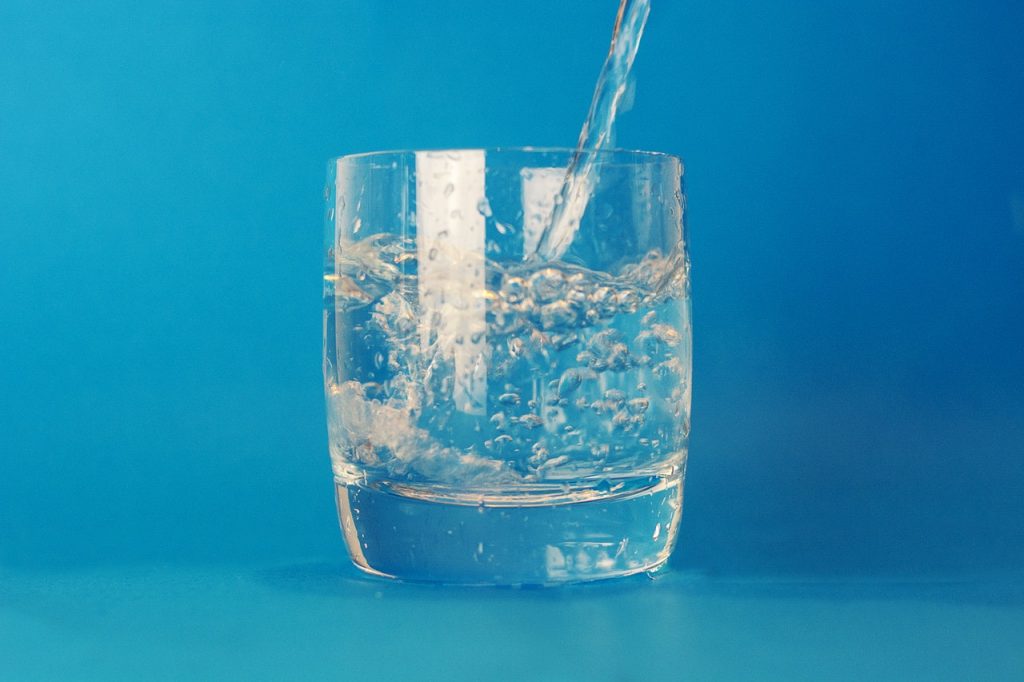
We’re going to delve a little deeper into what an RO system is, what it can do, and what makes them so popular. These systems are pretty complex and they have a reputation for producing pure, great tasting drinking water, but the sheer cost of a reverse osmosis system is enough to turn some buyers off to this option.
A reverse osmosis system uses water pressure to force the water molecules through a fine membrane that essentially removes all of the contaminants.
The purified water is collected from the permeate side of the membrane, while the water that contains the concentrated amount of contaminants is forced down the drain into the contaminated side of the filter system. Most models consist of a carbon filter, chlorine and sediment pre-filter, membrane, and a storage tank.
Extensive RO Filtration Stages
Sediment: Removes large particles including rust and sand.
Carbon: Removes chemicals such as chlorine from the water. These chemicals can potentially damage the membrane if they’re not effectively removed during this stage.
RO: This stage removes anything that’s larger than a water molecule and it’s where the bulk of purification takes place.
Remineralization: Water that’s highly purified is slightly acidic. Some reverse osmosis systems will remineralize the water with magnesium and calcium in order to balance the Ph levels, introducing healthy minerals and improving the taste of the water.
Second Carbon Stage: This stage is referred to as polishing. This second carbon filter will remove any odors or taste that the reverse osmosis stage failed to pick up.
As you can see, reverse osmosis systems offer an extensive filtering process that’s designed to eliminate a wider range of harmful contaminants from the water. However, these systems are much more expensive than conventional and simple under the sink filter systems. Additionally, the installation process can be very complicated and time-consuming.
Final Thoughts
These reviews of the leading models are designed to give you a closer look at what each system has to offer while also learning more about each model’s pros and cons and how they rated with homeowners. Our goal is to provide you with all the information you need to make an informed decision when it comes time to choose an under the sink water filter that will work for you and your family.
If you have any questions on this article, please email us or connect with us below with comments.
See Also:

